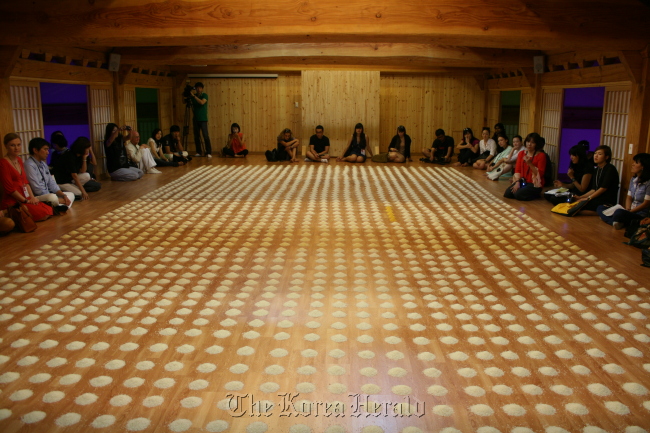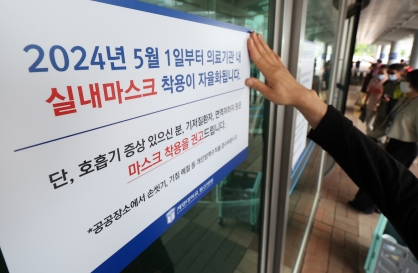Gwangju Biennale involves visitors in the artwork
By Lee Woo-youngPublished : Sept. 7, 2012 - 20:21

Asia’s largest art event invites citizens, visitors to become part of artwork
The city of Gwangju has again turned itself into a huge contemporary art exhibition that experiments with and showcases the latest trends in the art world.
The 9th Gwangju Biennale, opened Thursday, offers a variety of artworks not only at the main exhibition hall, but also at sites such as a Buddhist temple, a local market and a theater.
Titled “Round Table,” this year’s exhibition features about 300 artworks by 92 artists from 40 countries, co-curated by six Asian women. The co-directing method is a new approach for the Biennale.
The theme is designed to reflect the biennale’s aim of embracing different ideas, including art, culture, and political and social issues, and forging common ground by inviting everyone to the roundtable.
“The six directors had different ideas about the festival and conflicts during our work process, but finally embraced the differences and created harmony. That’s the background of choosing this year’s theme. I wanted to talk about Gwangju first, since I arrived in Gwangju to prepare for the biennale,” said the Korean director Kim Sun-jung.
Founded in 1995 in memory of the 1980 civil uprising for democratization in Gwangju, the biennale has striven to serve as an experimental platform for art and friendly festival for citizens to participate in what is sometimes seen as an abstract and conceptual art event.
Asian identity
The biennale focuses on Asian identity with about half of the participating artists from Asian countries.
The artists reflect social and political situations in their countries or those happening globally in the forms of paintings, installations, sculptures and videos.
Korean American artist Michael Joo’s installation “Indivisible,” a group of shields hung from the ceiling, takes up a large space in the first exhibition hall. The array of shields, used in protests and demonstrations as an offensive force of government authority, alludes to the recent rise of civic movements globally.
Japanese artist Motoyuki Shitamichi presents photographs of “torii” gates, the front gate of Japanese shrines across East Asian countries built under a Japanese campaign to create “greater East Asian sphere,” until the outbreak of World War II. The photographs show those gates now abandoned and how they exist in a completely different landscape and social context.
Participatory art offers fun
Citizens and visitors to the exhibition are invited to become part of the artwork or complete them.
Korean installation artist Suh Do Ho recreates an old store of a local market, a university dormitory room and a room in an old house in the exhibition hall with “Rubbing Project.”
Suh gathered individual traces and experiences of such spaces by having visitors and local citizens place papers on wall surfaces and rub them with colored pencils or charcoals. The papers are rubbed against new walls in a new room placed in the exhibition hall.
A group of three artist from China, Korea and Japan ― Chen Shaoxiong, Gim Hong-sok, Tsuyoshi Ozawa ― created a fictional city of Xijing and attempt to draw visitors’ participation as they ask them to sing or dance when they go through the immigration check.
Belgian artist Sara Nuytemans invites viewers into her rotating stainless steel round ball to experience meditation. The installation evokes different reactions and emotions for each participant.
For children, Scott Eady rents bikes as part of his “The 100 Bikes Project.” Eady recycled second hand bicycles, tricycles and scooters and turned them into new ones, adding new colors and replacing parts.
Outdoor exhibition hall
The festive mood of the biennale is felt in every corner of Gwangju.
Suh built “In Between Hotel” where visitors can actually stay. During the exhibition, the hotel moves and relocates to several places throughout the city so that viewers can visit and experience different sites.
“Although the hotel is designed for guests from outside Gwangju to help them discover the city, but it also offers an opportunity for citizens to draw attention to their neighborhoods,” said Suh.
The mobile room installed on a 1.2 ton truck, comes complete with a single bed, mirror, and even its own bathroom and shower facilities and basic amenities.
Those who wish to stay can make a reservation at www.inbetweenhotel.com during the biennale period. The organizers say they plan to operate the hotel after the biennale ends.
The tranquil Buddhist temple Mugaksa opens its door to outside visitors during the exhibition period with four installation works, designed to offer emotional cleansing and release for visitors.
Kim Ju-yeon’s “Erasing Memory” features a pile of salt and an instruction to help visitors participate in the moment for meditation and concentration on their emotions.
Visitors are asked to take off their shoes and socks and place their feet on a pile of salt and have a moment to think about the memories they want to erase.
“Salt is a symbol of purity and cleansing in various cultures and I adopted the idea into my work and help visitors release and dissolve memories and fragments through meditation,” said Kim.
The city of Gwangju has again turned itself into a huge contemporary art exhibition that experiments with and showcases the latest trends in the art world.
The 9th Gwangju Biennale, opened Thursday, offers a variety of artworks not only at the main exhibition hall, but also at sites such as a Buddhist temple, a local market and a theater.
Titled “Round Table,” this year’s exhibition features about 300 artworks by 92 artists from 40 countries, co-curated by six Asian women. The co-directing method is a new approach for the Biennale.
The theme is designed to reflect the biennale’s aim of embracing different ideas, including art, culture, and political and social issues, and forging common ground by inviting everyone to the roundtable.
“The six directors had different ideas about the festival and conflicts during our work process, but finally embraced the differences and created harmony. That’s the background of choosing this year’s theme. I wanted to talk about Gwangju first, since I arrived in Gwangju to prepare for the biennale,” said the Korean director Kim Sun-jung.
Founded in 1995 in memory of the 1980 civil uprising for democratization in Gwangju, the biennale has striven to serve as an experimental platform for art and friendly festival for citizens to participate in what is sometimes seen as an abstract and conceptual art event.
Asian identity
The biennale focuses on Asian identity with about half of the participating artists from Asian countries.
The artists reflect social and political situations in their countries or those happening globally in the forms of paintings, installations, sculptures and videos.
Korean American artist Michael Joo’s installation “Indivisible,” a group of shields hung from the ceiling, takes up a large space in the first exhibition hall. The array of shields, used in protests and demonstrations as an offensive force of government authority, alludes to the recent rise of civic movements globally.
Japanese artist Motoyuki Shitamichi presents photographs of “torii” gates, the front gate of Japanese shrines across East Asian countries built under a Japanese campaign to create “greater East Asian sphere,” until the outbreak of World War II. The photographs show those gates now abandoned and how they exist in a completely different landscape and social context.
Participatory art offers fun
Citizens and visitors to the exhibition are invited to become part of the artwork or complete them.
Korean installation artist Suh Do Ho recreates an old store of a local market, a university dormitory room and a room in an old house in the exhibition hall with “Rubbing Project.”
Suh gathered individual traces and experiences of such spaces by having visitors and local citizens place papers on wall surfaces and rub them with colored pencils or charcoals. The papers are rubbed against new walls in a new room placed in the exhibition hall.
A group of three artist from China, Korea and Japan ― Chen Shaoxiong, Gim Hong-sok, Tsuyoshi Ozawa ― created a fictional city of Xijing and attempt to draw visitors’ participation as they ask them to sing or dance when they go through the immigration check.
Belgian artist Sara Nuytemans invites viewers into her rotating stainless steel round ball to experience meditation. The installation evokes different reactions and emotions for each participant.
For children, Scott Eady rents bikes as part of his “The 100 Bikes Project.” Eady recycled second hand bicycles, tricycles and scooters and turned them into new ones, adding new colors and replacing parts.
Outdoor exhibition hall
The festive mood of the biennale is felt in every corner of Gwangju.
Suh built “In Between Hotel” where visitors can actually stay. During the exhibition, the hotel moves and relocates to several places throughout the city so that viewers can visit and experience different sites.
“Although the hotel is designed for guests from outside Gwangju to help them discover the city, but it also offers an opportunity for citizens to draw attention to their neighborhoods,” said Suh.
The mobile room installed on a 1.2 ton truck, comes complete with a single bed, mirror, and even its own bathroom and shower facilities and basic amenities.
Those who wish to stay can make a reservation at www.inbetweenhotel.com during the biennale period. The organizers say they plan to operate the hotel after the biennale ends.
The tranquil Buddhist temple Mugaksa opens its door to outside visitors during the exhibition period with four installation works, designed to offer emotional cleansing and release for visitors.
Kim Ju-yeon’s “Erasing Memory” features a pile of salt and an instruction to help visitors participate in the moment for meditation and concentration on their emotions.
Visitors are asked to take off their shoes and socks and place their feet on a pile of salt and have a moment to think about the memories they want to erase.
“Salt is a symbol of purity and cleansing in various cultures and I adopted the idea into my work and help visitors release and dissolve memories and fragments through meditation,” said Kim.

On the second floor, German artist Wolfgang Laib laid out small piles of rice on a large wooden floor of the temple hall. As the title “Unlimited Ocean” indicates, the work creates the indefinitely stretching ocean and prompts viewers to reconsider the fundamental meaning of life.
At Daein Market, a local traditional market in the city, serves as an open platform for both visitors and artists to interact and enjoy art in a more casual way.
Due to the decreasing number of customers, artists now fill some empty store spots and display their works.
It also draws foreign artists like Japanese artist Soichiro Mikaya, who is participating in the residency program of the biennale. He has set up an installation piece, inspired by the Chunhyang story at the corner of the market space. He combines the imprisonment of Chunhyang and censorship that graffiti artists often face in the form of cage and swings.
At Gwangju Cinema, built in the 1930s and one of the oldest theaters in the nation, plays documentaries and essay films at 5 p.m. during the biennale.
The biennale continues through Nov. 11 at the main exhibition hall and different venues of the city. For more information, visit www.gwangjubiennale.org or call (062) 608-4224.
By Lee Woo-young (wylee@heraldcorp.com)




![[Music in drama] Rekindle a love that slipped through your fingers](http://res.heraldm.com/phpwas/restmb_idxmake.php?idx=644&simg=/content/image/2024/05/01/20240501050484_0.jpg&u=20240501151646)

![[New faces of Assembly] Architect behind ‘audacious initiative’ believes in denuclearized North Korea](http://res.heraldm.com/phpwas/restmb_idxmake.php?idx=644&simg=/content/image/2024/05/01/20240501050627_0.jpg&u=20240502093000)



![[KH Explains] Will alternative trading platform shake up Korean stock market?](http://res.heraldm.com/phpwas/restmb_idxmake.php?idx=644&simg=/content/image/2024/05/01/20240501050557_0.jpg&u=20240501161906)







![[Today’s K-pop] Stray Kids go gold in US with ‘Maniac’](http://res.heraldm.com/phpwas/restmb_idxmake.php?idx=642&simg=/content/image/2024/05/02/20240502050771_0.jpg&u=)